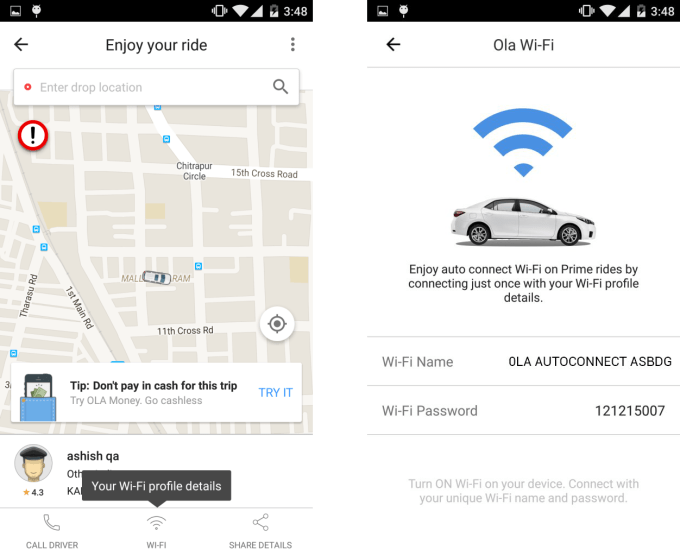Ola, Uber’s rival in India, wants to create metropolitan Wi-Fi networks powered by taxis
Programs from Facebook and Google could make the crazy idea of getting internet access via a hot air balloon or lasers shot from a drone a reality, but how about going online via a network of Wi-Fi-connected taxis in your city. That latter option could become a possibility in the future thanks to a new program from Ola, the India-based ride on-demand service that is valued at $5 billion and fiercely rivaling Uber.
Ola today announced a new Wi-Fi feature for its high-end cars that will enable customers to automatically connect to a Wi-Fi network when they get into a vehicle — no hassle with registration, codes or hotspot connections. Ola’s “Auto-Connect Wi-Fi” requires one initial log-in, after which a user automatically rejoins the Wi-Fi network in any Ola Prime vehicle.
Ola and Uber both began offering in-car Wi-Fi last year, but both required a fresh log-in each time. The feature could soon become standard for high-end on-demand rides in India, where network connectivity isn’t always reliable, so automatic log-ins could become a convenient time saver.
“Ola Wi-Fi addresses the need for consumers to be connected to the internet while on the go, without the hassles of having to use unique credentials every single time. With over 40 minutes spent on an average cab ride in Indian cities, an auto-connect Wi-Fi experience can make every Ola, the ‘third place’ for consumers, beyond their home and workplace,” Raghuvesh Sarup, head of categories and chief marketing officer at Ola, said in a statement.

The feature is initially available with Ola Prime, the company’s UberBLACK-esque high-end category, and is limited to three cities at first. Sarup told TechCrunch that the company is “making plans” to expand the automatic Wi-Fi service to other cities and all other Ola vehicle types, including even its Tuktuk service, in a phased manner, but there’s no immediate timeframe for when that will happen. It isn’t also clear if the service, which is free with Prime, would be charged separately when added to lower end Ola cars like Tuktuks.
Ola is working with multiple providers — it declined to name names — to power the network. Each vehicle contains a Wi-Fi device which emits a network signal with a limited range. But, there’s a grand idea lurking. Further down the line, the company could extend the range in each vehicle and thus create a mesh-style Wi-Fi network that, if there are enough cards on the road, could provide a solid connection for anyone in a particular area. In other words: Ola’s cars could literally be beacons that power a metropolitan Wi-Fi network.
“We are trying to solve one use case first,” Ankit Bhati, Ola CTO and co-founder, said in an interview. “Potentially [we] can use the nodes [to create a network.] We definitely want to get to a future where that is possible. One step at a time, but the potential is huge.”
Ola’s news is line with recent measures that the Indian government is undertaking to improve connectivity in the country, which is already the world’s second largest internet market and counts over 140 million monthly active Facebook users. Google and the government launched a program to bring Wi-Fi coverage to India’s rail network in January, and there may be parallels here.
Ola didn’t work directly with the government on its Wi-Fi service, but it is open to doing so in the future Anand Subramanian, Ola’s head of communications, told us.
If Ola can create Wi-Fi networks in the future, and it is a huge ask, it wouldn’t represent the first time that its reach has extended beyond merely transportation services. The company’s payment service — payment wallets are mandatory for all on-demand services in India — was spun out into a standalone app that can be used to pay for items on a range of other services beyond Ola.















![Toni Kroos là ai? [ sự thật về tiểu sử đầy đủ Toni Kroos ]](https://evbn.org/wp-content/uploads/New-Project-6635-1671934592.jpg)


